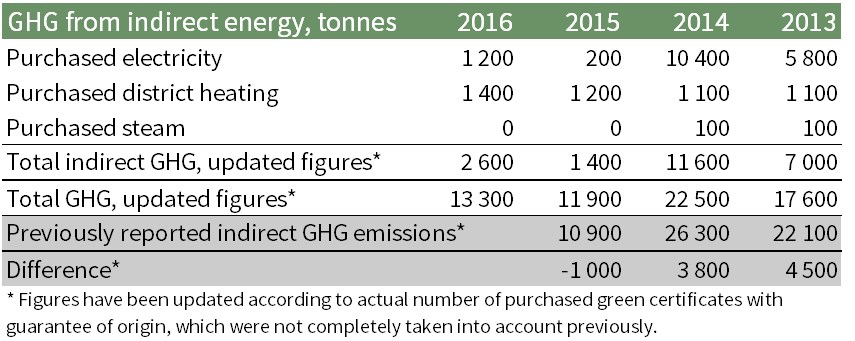GRI-Appendix
Emissions
DMA - Emissions
Reference AR 23 Pdf, 8.4 MB.» Pdf, 8.4 MB.
Emissions to air consists of GHG, NOx, SOx and VOC. Tracking and minimising GHG emissions is important for all companies within NIBE Group, both production and sales companies. Besides generating GHG emissions from energy use, we also use refrigerant in our products and in own installations, which generate some diffuse emissions of refrigerants to the atmosphere. These losses are calculated based on need for refilling and the climate depleting potential is calculated as CO2 equivalents according to GHG protocol.
Transportation is an area where we are developing the reporting of GHG emissions. Today we can track and report the GHG emissions from our own vehicles. We are beginning to get data for purchased transportation and business travels but do not have enough accurate data to be able to report it yet.
Depending on the type of production process other types emissions can be more or less material, but since some of the companies have air emissions as a significant environmental aspect, we regard it as important for the whole NIBE Group and as something that we should work to minimise.
We have an indirect targets to reduce our GHG emission intensity. The target is expressed in terms of reducing energy use by 30% from 2013 to 2020 (measured as MWh/SEK million in sales). We have reached that target already in 2016. Targets will be reviewed during 2017.
All our use of electricity is bought with a "green certificate", which means that it is generated from renewable sources (GoO, Guarantee of Origin).
We also aim to minimise the carbon footprint in our supply chain, as well as during the whole lifecycle of our products. We do not have sufficient data to able to report this today.
G4-EN15 - Direct GHG emissions
In 2016, carbon dioxide emissions from energy use in our own production plants, purchased electricity and heat amounted to 12,100 (10,900) tonnes. Natural gas, LPG and oil used in production processes stood for 88% or 10,700 tonnes. As from 2015, the Company has increased the purchase of electricity with a certificate of origin from renewable sources, which accounts for the big reduction in CO2 emissions between 2014 and 2015.
In additon to direct emissions, there are emissions from use of diesel and petrol in our own vehicles, which amount to 5,800 tonnes, an increase of 600 tonnes on the previous year. Our ambition is to gradually switch to vehicles fuelled by renewable energy.


G4-EN16 - Indirect GHG emissions

G4-EN17 - Other indirect GHG emissions
No other indirect GHG emissions are reported.
G4-EN18 - GHG emissions intensity


G4-EN19 - Reduction of GHG emissions
The foremost reduction is due to the purchasing of green electricity certificates with guarantee of renewable origin (GoO).
G4-EN20 - Emissions of ozone-depleting substances
No use of ozone depleting substances has been reported.
G4-EN21 - NOx, SOx, and other significant air emissions
This aspect is mainly important for one of our production sites; Northstar Poland Sp. z.o.o. that reports 63% of our NOx emissions and 93% of our SOx emissions. Even so, we ask all our production sites to report their air emissions so we can see changes over time and monitor whether we use the best available technology.

